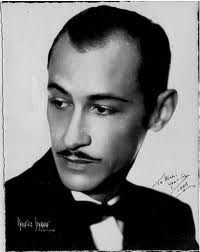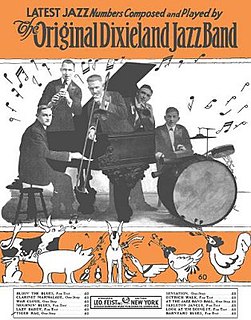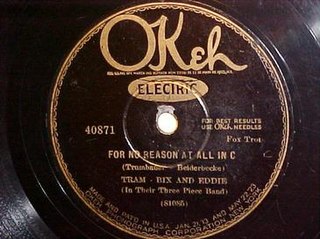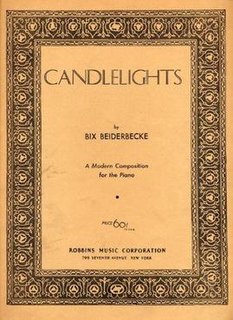Related Research Articles

Leon Bismark "Bix" Beiderbecke was an American jazz cornetist, pianist and composer.

The Original Dixieland Jass Band (ODJB) was a Dixieland jazz band that made the first jazz recordings in early 1917. Their "Livery Stable Blues" became the first jazz record ever issued. The group composed and recorded many jazz standards, the most famous being "Tiger Rag". In late 1917, the spelling of the band's name was changed to Original Dixieland Jazz Band.

Dominic James "Nick" LaRocca, was an American early jazz cornetist and trumpeter and the leader of the Original Dixieland Jass Band. He is the composer of one of the most recorded jazz classics of all-time, "Tiger Rag". He was part of what is generally regarded as the first recorded jazz band, a band which recorded and released the first jazz recording, "Livery Stable Blues" in 1917.

Joseph Russel Robinson was an American ragtime, dixieland, and blues pianist and composer who was a member of the Original Dixieland Jass Band.

Joseph Gustaf "Sharkey" Bonano, also known as Sharkey Banana or Sharkey Bananas, was an American jazz trumpeter, band leader, and vocalist. His musical abilities were sometimes overlooked because of his love of being an entertainer; he would often sing silly lyrics in a high raspy voice and break into dance on stage.

Orie Frank Trumbauer was one of the leading jazz saxophonists of the 1920s and 1930s. His main instrument was the C-melody saxophone, a now-uncommon instrument between an alto and tenor saxophone in size and pitch. He also played alto saxophone, bassoon, clarinet and several other instruments.

"Tiger Rag" is a jazz standard that was recorded and copyrighted by the Original Dixieland Jass Band in 1917. It is one of the most recorded jazz compositions. In 2003, the 1918 recording of "Tiger Rag" was entered into the U.S. Library of Congress National Recording Registry.

Henry W. Ragas was a jazz pianist who was a member of the Original Dixieland Jazz Band, the first jazz band to record commercially.

The Wolverines were an American jazz band. They were one of the most successful territory bands of the American Midwest in the 1920s.

"Margie", also known as "My Little Margie", is a 1920 popular song composed in collaboration by vaudeville performer and pianist Con Conrad and ragtime pianist J. Russel Robinson, a member of the Original Dixieland Jazz Band. Lyrics were written by Benny Davis, a vaudeville performer and songwriter. The song was introduced by the Original Dixieland Jazz Band in 1920 as Victor 78, 18717-A, in a medley paired with "Singin' the Blues". The B side was "Palesteena". The ODJB recorded their instrumental version on December 1, 1920.
Other popular versions in 1920-21 were by Gene Rodemich; Eddie Cantor; Ted Lewis; and Frank Crumit. The Rega Dance Orchestra recorded the song in October, 1920 for Okeh Records, 4211.

"Riverboat Shuffle" is a popular song composed by Hoagy Carmichael, Irving Mills and Dick Voynow, and with lyrics added later by Carmichael and Mitchell Parish. First recorded by Bix Beiderbecke and The Wolverines in 1924, it was Carmichael's first composition and would become a Dixieland standard. The Wolverines released the song as a Gennet 78, 5454-A, Matrix #11854 524, in 1924. Bix Beiderbecke recorded a second version of the song in 1927 with Frankie Trumbauer and His Orchestra which was released as an Okeh 78, 40822. Carmichael would later write many popular jazz standards, including "Stardust" (1927), "Georgia on My Mind" (1930) and "Lazy River" (1931).

"In a Mist" is a 1927 composition for piano by Bix Beiderbecke.

"For No Reason at All in C" is a 1927 jazz instrumental by Bix Beiderbecke, Frankie Trumbauer, and Eddie Lang. The song was released as a 78 single in 1927 on Okeh Records as by "Tram, Bix and Eddie ".

"Sensation Rag" or "Sensation" is a 1918 jazz instrumental by the Original Dixieland Jazz Band. It is one of the earliest jazz recordings. It is not related to Joseph Lamb's 1908 "Sensation Rag", which is a ragtime piano piece.

"At the Jazz Band Ball" is a 1917 jazz instrumental recorded by the Original Dixieland Jazz Band. The instrumental is one of the earliest and most recorded jazz compositions. It is a jazz classic and a standard of the genre.

"Candlelights" is a 1930 jazz composition for solo piano by cornetist Bix Beiderbecke. It was the second in the series of four piano works which Bix Beiderbecke composed during his career.

Copenhagen is a jazz standard composed in 1924 by bandleader Charlie Davis and first recorded in that year by the Wolverine Orchestra featuring Bix Beiderbecke in a foxtrot tempo. The title refers to Copenhagen tobacco, favored by Davis's bass player. Lyrics were added by Walter Melrose to the tune, which is a blues in B-flat.

Clarinet Marmalade, later Clarinet Marmalade Blues, is a 1918 dixieland jazz standard composed by Larry Shields and Henry Ragas of the Original Dixieland Jass Band. It is played in the key of F major. It was recorded by Fletcher Henderson in 1926 and Frankie Trumbauer in 1927.

"Singin' the Blues" is a 1920 jazz composition by J. Russel Robinson, Con Conrad, Sam M. Lewis, and Joe Young. It was recorded by the Original Dixieland Jass Band in 1920 as an instrumental and released as a Victor 78 as part of a medley with "Margie". The song was released with lyrics by vocalist Aileen Stanley in 1920 on Victor. In 1927, Frank Trumbauer, Bix Beiderbecke, and Eddie Lang recorded and released the song as an Okeh 78. The Trumbauer recording is considered a jazz and pop standard, greatly contributing to Frank Trumbauer and Bix Beiderbecke's reputation and influence. It is not related to the 1956 pop song "Singing the Blues" first recorded and released by Marty Robbins in 1956.

Ostrich Walk" is a 1917 jazz composition by the Original Dixieland Jass Band released as an instrumental as an Aeolian Vocalion and a Victor 78. Frankie Trumbauer and Bix Beiderbecke recorded the song in 1927. The song is a jazz milestone as one of the first commercially released "jass" or jazz recordings.
References
- ↑ "Fidgety Feet". Jazzstandards.com. Retrieved 30 May 2020.
- ↑ "Fidgety feet". Library of Congress. Retrieved 30 May 2020.
- ↑ Hoffman, Frank (2004). Encyclopedia of Recorded Sound. Routledge. p. 1070. ISBN 9781135949501.
- ↑ "Fidgety Feet". secondhandsongs.com. Retrieved 30 May 2020.
- ↑ Lion, Jean Pierre (2005). Bix: The Definitive Biography of a Jazz Legend. Bloomsbury. p. 63. ISBN 9780826416995.